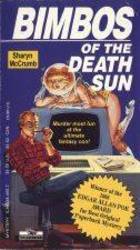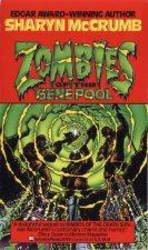

| Sharyn McCrumb is primarily a mystery writer, but she has written two novels with science fiction fandom as the backdrop. | ||
| Click on a book's image or title to order from Amazon.com |

Bimbos of the Death Sun
TSR Books, © 1988, ISBN #0-88038-455-7Reviewed 1997
McCrumb is primarily a mystery writer by trade, I understand, and this book (which won an Edgar award) is indeed a mystery, albeit one set at a science fiction convention. As a result, McCrumb has become somewhat infamous in fandom.
The book left me with a very strong feeling that McCrumb had only a passing knowledge of what fandom is like, as the book presents the most cliched and negative image of fans that I can imagine. Almost to a man, fans in Bimbos tend to be fat, slovenly, obsessive, and frequently ill-tempered. The worst example is a hefty "femmefan" (a term I've never actually heard used in fandom) who zeros in on some dweeb to relieve him of his virginity, and then when she learns that he's a budding engineer, decides that she's better get pregnant to hold on to him. (And then these two characters never show up in the book again, so what's the point?)
To be sure, there are fat, slovenly, obsessive and ill-tempered fans, but there are fat, slovenly, obsessive and ill-tempered non-fans, too. And I know plenty of fans who are real folks who happen to be interested in science fiction or fantasy enough to attend conventions. McCrumb's sin is that she doesn't present any sort of a balanced view of fandom. The only "normal people" in her book are pretty definitively characterized as outsiders: The protagonist, Jay Omega, the former fan, Dr. Marion Farley, and the cop investigating the murder that occurs during the convention.
Ah, yes, the murder. This is a mystery novel, after a fashion. An unlikely author with the unlikely name of Appin Dungannon is killed and Jay and company must find out whodunnit. But since I didn't really care much about most of these characters, and since there wasn't a whole lot hinging on finding out whodunnit, and since the process of finding out whodunnit was singularly pedestrian, I again ended up wondering, what's the point?
Ultimately, I honestly don't have much to say in praise of this novel, and I'm mystified that it won any sort of award. If you're looking for a good mystery, or if you're looking for some sort of fictional characterization of science fiction fandom, fer gosh sakes don't buy this book expecting to find it.
P.S.: Oh, yeah; the title, Bimbos of the Death Sun, is the title of the novel which Jay Omega wrote, and which resulted in him becoming co-guest-of-honor at the con in question.

Zombies of the Gene Pool
Ballantine Books, © 1992, ISBN #0-345-37914-4Reviewed 1997
This is a far superior book to Bimbos of the Death Sun, and it's easy to see why: The book starts with a real plot, rather than, "oh, it's a murder at a science fiction convention."
To wit: In the 1950s, a group of young adults lived together for a brief time on a farm in the South and dubbed themselves the Lanthanides (presumably directly based on the real-life "Futurians" group of early SF fandom). After a failed effort to attend a Worldcon in San Francisco, they are inspired to create a time capsule into which they each place the only copy of a story they have written. The group breaks up soon thereafter, and a few years later a dam built on the Watauga River floods the valley.
Forty years later, the Lanthanides have grown up to become many things: Professional writers, a Hollywood mogul, a college professor, a lawyer, and, in several cases, dead. Then it is learned that the lake that flooded the valley is going to be drained for three weeks, during which the time capsule can be retrieved. Since several former Lanthanides are now famous, the time capsule is theoretically very valuable. So the surviving Lanthanides hold a reunion to exhume the capsule, and, of course, their pasts.
The heroes of the first book, Jay Omega and Marion Farley, accompany their fellow professor to the reunion.
This book treats fans with much more respect (and realism) than its predecessor did, although McCrumb still seems to have a blind spot when it comes to people who are not extremely eccentric and yet are still fans; the majority of the characters who are not portrayed as bizarre or pathetic in some way seem focused on getting out of or staying away from fandom. Nonetheless, it's good to see that she's not having her non-fan characters gape with incomprehension at everything that fans do.
The book is a murder mystery, but like Bimbos the murder is only one of many events chronicled in the book. Unlike Bimbos, the other aspects of the book are interesting in their own right, and ultimately it is the characterization of the Lanthanides and their history which carries the book. It is the return of a Lanthanide thought long dead which provides the motive force for the core drama of the book, and ultimately the book is brought to a satisfying conclusion.
hits since 13 August 2000.